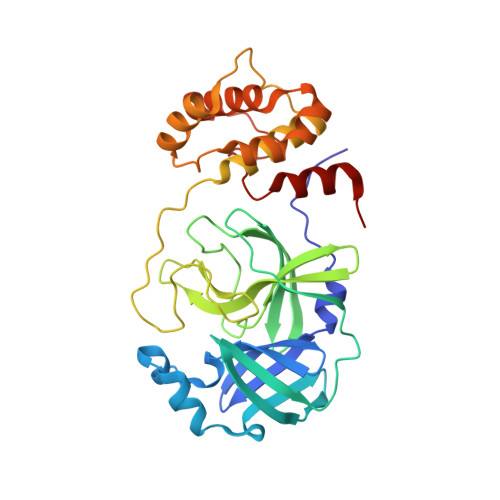Crystallographic and electrophilic fragment screening of the SARS-CoV-2 main protease.
Douangamath, A., Fearon, D., Gehrtz, P., Krojer, T., Lukacik, P., Owen, C.D., Resnick, E., Strain-Damerell, C., Aimon, A., Abranyi-Balogh, P., Brandao-Neto, J., Carbery, A., Davison, G., Dias, A., Downes, T.D., Dunnett, L., Fairhead, M., Firth, J.D., Jones, S.P., Keeley, A., Keseru, G.M., Klein, H.F., Martin, M.P., Noble, M.E.M., O'Brien, P., Powell, A., Reddi, R.N., Skyner, R., Snee, M., Waring, M.J., Wild, C., London, N., von Delft, F., Walsh, M.A.(2020) Nat Commun 11: 5047-5047
- PubMed: 33028810
- DOI: https://doi.org/10.1038/s41467-020-18709-w
- Primary Citation of Related Structures:
5R7Y, 5R7Z, 5R80, 5R81, 5R82, 5R83, 5R84, 5RE4, 5RE5, 5RE6, 5RE7, 5RE8, 5RE9, 5REA, 5REB, 5REC, 5RED, 5REE, 5REF, 5REG, 5REH, 5REI, 5REJ, 5REK, 5REL, 5REM, 5REN, 5REO, 5REP, 5RER, 5RES, 5RET, 5REU, 5REV, 5REW, 5REX, 5REY, 5REZ, 5RF0, 5RF1, 5RF2, 5RF3, 5RF4, 5RF5, 5RF6, 5RF7, 5RF8, 5RF9, 5RFA, 5RFB - PubMed Abstract:
COVID-19, caused by SARS-CoV-2, lacks effective therapeutics. Additionally, no antiviral drugs or vaccines were developed against the closely related coronavirus, SARS-CoV-1 or MERS-CoV, despite previous zoonotic outbreaks. To identify starting points for such therapeutics, we performed a large-scale screen of electrophile and non-covalent fragments through a combined mass spectrometry and X-ray approach against the SARS-CoV-2 main protease, one of two cysteine viral proteases essential for viral replication. Our crystallographic screen identified 71 hits that span the entire active site, as well as 3 hits at the dimer interface. These structures reveal routes to rapidly develop more potent inhibitors through merging of covalent and non-covalent fragment hits; one series of low-reactivity, tractable covalent fragments were progressed to discover improved binders. These combined hits offer unprecedented structural and reactivity information for on-going structure-based drug design against SARS-CoV-2 main protease.
- Diamond Light Source Ltd., Harwell Science and Innovation Campus, Didcot, OX11 0QX, UK.
Organizational Affiliation:


















